Evaluation Analysis of Landsat Level-1 and Level-2 Data Products Using In Situ Measurements
Abstract
:1. Introduction
2. Landsat-7 ETM+ and Landsat-8 OLI Product Levels (Level-1 and Level-2 Data)
2.1. Landsat Level-1 Data: Top of Atmosphere (TOA) Reflectance
2.2. Landsat Level-2 Data: Bottom of Atmosphere (BOA) Reflectance (Surface Reflectance)
3. In Situ Measurements
3.1. Tuz Gölü—Turkey
3.2. Crop Region Site—Brazil
3.3. Atacama Desert—Chile
3.4. Algodones Dunes Site—USA
3.5. SDSU Vegetative Site—USA
3.6. RVUS RadCalNet Site—USA
3.7. LCFR RadCalNet Site—France
3.8. GONA RadCalNet Site—Namibia
4. Data Evaluation and Comparison Methodology
5. Results and Discussion
5.1. Landsat-7 and Landsat-8 Level-1 Data Product Evaluation Results
5.2. Landsat-7 and Landsat-8 Level-2 Data Product Evaluation Results
6. Conclusions
Author Contributions
Funding
Acknowledgments
Conflicts of Interest
References
- Lamquin, N.; Woolliams, E.; Bruniquel, V.; Gascon, F.; Gorroño, J.; Govaerts, Y.; Leroy, V.; Lonjou, V.; AlHammoud, B.; Barsi, J.A.; et al. An inter-comparison exercise of Sentinel-2 radiometric validations assessed by independent expert groups. Remote Sens. Environ. 2019, 233, 111369. [Google Scholar] [CrossRef]
- Pinto, C.T.; Ponzoni, F.J.; Castro, R.; Leigh, L.; Mishra, N.; Aaron, D.; Helder, D. First in-flight radiometric calibration of MUX and WFI on-board CBERS-4. Remote Sens. 2016, 8, 405. [Google Scholar] [CrossRef] [Green Version]
- Biggar, S.; Slater, P.; Gellman, D. Uncertainties in the in-flight calibration of sensors with reference to measured ground sites in the 0.4–1.1 μm range. Remote Sens. Environ. 1994, 48, 245–252. [Google Scholar] [CrossRef]
- Hagolle, O.; Huc, M.; Pascual, D.V.; Dedieu, G. A Multi-temporal and multi-spectral method to estimate aerosol optical thickness over land, for the atmospheric correction of Formosat-2, LandSat, VENμS and Sentinel-2 images. Remote Sens. 2015, 7, 2668–2691. [Google Scholar] [CrossRef] [Green Version]
- Vermote, E.F.; Kotchenova, S. Atmospheric correction for the monitoring of land surfaces. J. Geophys. Res. Space Phys. 2008, 113. [Google Scholar] [CrossRef]
- Vermote, E.F.; Justice, C.; Claverie, M.; Franch, B. Preliminary analysis of the performance of the Landsat 8/OLI land surface reflectance product. Remote Sens. Environ. 2016, 185, 46–56. [Google Scholar] [CrossRef]
- Markham, B.; Storey, J.; Williams, D.; Irons, J. Landsat sensor performance: History and current status. IEEE Trans. Geosci. Remote Sens. 2004, 42, 2691–2694. [Google Scholar] [CrossRef]
- Markham, B.; Helder, D. Forty-year calibrated record of earth-reflected radiance from Landsat: A review. Remote Sens. Environ. 2012, 122, 30–40. [Google Scholar] [CrossRef] [Green Version]
- Roy, D.P.; Wulder, M.A.; Loveland, T.R.; Woodcock, C.E.; Allen, R.G.; Anderson, M.C.; Helder, D.; Irons, J.R.; Johnson, D.M.; Kennedy, R.; et al. Landsat-8: Science and product vision for terrestrial global change research. Remote Sens. Environ. 2014, 145, 154–172. [Google Scholar] [CrossRef] [Green Version]
- Loveland, T.R.; Irons, J.R. Landsat 8: The plans, the reality, and the legacy. Remote Sens. Environ. 2016, 185, 1–6. [Google Scholar] [CrossRef] [Green Version]
- Wulder, M.A.; Loveland, T.R.; Roy, D.P.; Crawford, C.J.; Masek, J.G.; Woodcock, C.E.; Allen, R.G.; Anderson, M.C.; Belward, A.S.; Cohen, W.B.; et al. Current status of Landsat program, science, and applications. Remote Sens. Environ. 2019, 225, 127–147. [Google Scholar] [CrossRef]
- Vermote, E.; Tanre, D.; Deuze, J.; Herman, M.; Morcette, J.J. Second simulation of the satellite signal in the solar spectrum, 6S: An overview. IEEE Trans. Geosci. Remote Sens. 1997, 35, 675–686. [Google Scholar] [CrossRef] [Green Version]
- Masek, J.G.; Vermote, E.F.; Saleous, N.E.; Wolfe, R.; Hall, F.G.; Huemmrich, F.; Gao, F.; Kutler, J.; Lim, T.K. A Landsat surface reflectance data set for North America, 1990–2000. IEEE Geosci. Remote Sens. Lett. 2006, 3, 68–72. [Google Scholar] [CrossRef]
- Masek, J.G.; Vermote, E.F.; Saleous, N.; Wolfe, R.; Hall, F.G.; Huemmrich, F.; Gao, F.; Kutler, J.; Lim., T.K. LEDAPS Calibration, Reflectance, Atmospheric Correction Preprocessing Code. 2013. Available online: https://daac.ornl.gov/MODELS/guides/LEDAPS_V2.html (accessed on 5 May 2020).
- Vermote, E.; Roger, J.C.; Franch, B.; Skakun, S. LaSRC (Land Surface Reflectance Code): Overview, application and validation using MODIS, VIIRS, LANDSAT and Sentinel 2 data’s. In Proceedings of the IGARSS—IEEE International Geoscience and Remote Sensing Symposium, Valencia, Spain, 23–27 July 2018; pp. 8173–8176. [Google Scholar]
- Feng, M.; Sexton, J.O.; Huang, C.; Masek, J.; Vermote, E.F.; Gao, F.; Narasimhan, R.; Channan, S.; Wolfe, R.E.; Townshend, J.R. Global surface reflectance products from Landsat: Assessment using coincident MODIS observations. Remote Sens. Environ. 2013, 134, 276–293. [Google Scholar] [CrossRef]
- Wang, Y.; Liu, L.; Hu, Y.; Li, N.; Li, Z. Development and validation of the Landsat-8 surface reflectance products using a MODIS-based per-pixel atmospheric correction method. Int. J. Remote Sens. 2016, 37, 1291–1314. [Google Scholar] [CrossRef]
- Wang, Y.; Lyapustin, A.; Privette, J.; Morisette, J.; Holben, B. Atmospheric correction at AERONET locations: A new science and validation data set. IEEE Trans. Geosci. Remote Sens. 2009, 47, 2450–2466. [Google Scholar] [CrossRef]
- Franch, B.; Vermote, E.; Claverie, M. Intercomparison of Landsat albedo retrieval techniques and evaluation against in situ measurements across the US SURFRAD network. Remote Sens. Environ. 2014, 152, 627–637. [Google Scholar] [CrossRef]
- Claverie, M.; Vermote, E.; Franch, B.; Masek, J.G. Evaluation of the Landsat-5 TM and Landsat-7 ETM+ surface reflectance products. Remote Sens. Environ. 2015, 169, 390–403. [Google Scholar] [CrossRef]
- Holben, B.; Eck, T.; Slutsker, I.; Tanre, D.; Buis, J.; Setzer, A.; Vermote, E.; Reagan, J.; Kaufman, Y.; Nakajima, T.; et al. AERONET—A federated instrument network and data archive for aerosol characterization. Remote Sens. Environ. 1998, 66, 1–16. [Google Scholar] [CrossRef]
- Dubovik, O.; Holben, B.; Eck, T.F.; Smirnov, A.; Kaufman, Y.J.; King, M.D.; Tanré, D.; Slutsker, I. Variability of absorption and optical properties of key aerosol types observed in worldwide locations. J. Atmospheric Sci. 2002, 59, 590–608. [Google Scholar] [CrossRef]
- U.S. Geological Survey (USGS). Landsat Collections. Available online: https://pubs.usgs.gov/fs/2018/3049/fs20183049.pdf (accessed on 7 May 2020).
- U.S. Geological Survey (USGS). Landsat 8 Collection 1. Data Available. Available online: https://www.usgs.gov/land-resources/nli/landsat/march-6-2017-landsat-8-collection-1-data-available (accessed on 7 May 2020).
- U.S. Geological Survey (USGS). Landsat Collection 2 Level-2 Science Products. Available online: https://www.usgs.gov/land-resources/nli/landsat/landsat-collection-2-level-2-science-products (accessed on 7 May 2020).
- U.S. Geological Survey (USGS). Landsat Collection 1 vs. Collection 2 Summary. 2020. Available online: https://prd-wret.s3.us-west-2.amazonaws.com/assets/palladium/production/atoms/files/Landsat-C1vsC2-20200210-lmws.pdf (accessed on 7 May 2020).
- Ihlen, V.; Zanter, K.; Department of the Interior, U.S. Geological Survey. Landsat 8 (L8) Data Users Handbook. Version 5.0. 2019, EROS, Sioux Falls, South Dakota. Available online: https://www.usgs.gov/media/files/landsat-8-data-users-handbook (accessed on 7 May 2020).
- Ihlen, V.; Zanter, K.; Department of the Interior, U.S. Geological Survey. Landsat 7 (L7) Data Users Handbook. Version 2.0. 2019, EROS, Sioux Falls, South Dakota. Available online: https://www.usgs.gov/media/files/landsat-7-data-users-handbook (accessed on 7 May 2020).
- Zanter, K.; Department of the Interior, U.S. Geological Survey. Landsat 4-7 Surface Reflectance (LEDAPS) Product Guide. Version 2.0. 2019, EROS, Sioux Falls, South Dakota. Available online: https://www.usgs.gov/media/files/landsat-4-7-surface-reflectance-code-ledaps-product-guide (accessed on 7 May 2020).
- Zanter, K.; Department of the Interior, U.S. Geological Survey. Landsat 8 Surface Reflectance Code (LASRC) Product Guide. Version 2.0. 2019, EROS, Sioux Falls, South Dakota. Available online: https://www.usgs.gov/media/files/land-surface-reflectance-code-lasrc-product-guide (accessed on 7 May 2020).
- Vermote, E.F.; Saleous, N.; Justice, C.O.; Kaufman, Y.J.; Privette, J.L.; Remer, L.; Roger, J.C.; Tanre, D. Atmospheric correction of visible to middle-infrared EOS-MODIS data over land surfaces: Background, operational algorithm and validation. J. Geophys. Res. Space Phys. 1997, 102, 17131–17141. [Google Scholar] [CrossRef] [Green Version]
- Kotchenova, S.Y.; Vermote, E.F.; Matarrese, R.; Klemm, J.F.J. Validation of a vector version of the 6S radiative transfer code for atmospheric correction of satellite data Part I: Path radiance. Appl. Opt. 2006, 45, 6762–6774. [Google Scholar] [CrossRef] [PubMed] [Green Version]
- Kotchenova, S.Y.; Vermote, E.F. Validation of a vector version of the 6S radiative transfer code for atmospheric correction of satellite data. Part II. Homogeneous Lambertian and anisotropic surfaces. Appl. Opt. 2007, 46, 4455–4464. [Google Scholar] [CrossRef] [PubMed] [Green Version]
- Kaufman, Y.J.; Wald, A.E.; Remer, L.A.; Gao, B.C.; Li, R.R.; Flynn, L. The MODIS 2.1 μm Channel—Correlation with visible reflectance for use in remote sensing of aerosol. IEEE Trans. Geosci. Remote Sens. 1997, 35, 1286–1298. [Google Scholar] [CrossRef]
- Helder, D.; Thome, K.; Aaron, D.; Leigh, L.; Czapla-Myers, J.; Leisso, N.; Biggar, S.; Anderson, N. Recent surface reflectance measurement campaigns with emphasis on best practices, SI traceability and uncertainty estimation. Metrologia 2012, 49, S21–S28. [Google Scholar] [CrossRef] [Green Version]
- Ozen, H.; Fox, N.; Gürbüz, S.Z.; Deadman, A.; Behnert, I.; Harris, P.; Yua, L.; Griffith, D.; Kaewmanee, M.; Prakobya, A.; et al. Preliminary Results of the Comparison of Satellite Imagers Using Tuz Gölü as a Reference Standard; International Archives of the Photogrammetry, Remote Sensing and Spatial Information Sciences: Melbourne, Australia, 2012; pp. 145–148. [Google Scholar]
- Committee on Earth Observation Satellites (CEOS) Cal/Val Portal. Lake Tüz Golu. Available online: http://calvalportal.ceos.org/tuz-golu (accessed on 8 May 2020).
- Pinto, C.T.; Ponzoni, F.J.; Barrientos, C.; Mattar, C.; Artigas, A.S.; Castro, R. Spectral and atmospheric characterization of a site at atacama desert for earth observation sensor calibration. IEEE Geosci. Remote Sens. Lett. 2015, 12, 2227–2231. [Google Scholar] [CrossRef]
- Martins, V.S.; Soares, J.V.; Novo, E.M.; Barbosa, C.C.; Pinto, C.T.; Arcanjo, J.S.; Kaleita, A.L. Continental-scale surface reflectance product from CBERS-4 MUX data: Assessment of atmospheric correction method using coincident Landsat observations. Remote Sens. Environ. 2018, 218, 55–68. [Google Scholar] [CrossRef]
- Vesilind, P.J. The driest place on Earth. Natl. Geogr. 2003, 204, 46–71. [Google Scholar]
- Houston, J.; Hartley, A.J. The central Andean west-slope rainshadow and its potential contribution to the origin of hyper-aridity in the Atacama Desert. Int. J. Clim. 2003, 23, 1453–1464. [Google Scholar] [CrossRef]
- McCorkel, J.; Bachmann, C.M.; Coburn, C.; Gerace, A.; Leigh, L.; Czapla-Myers, J.S.; Helder, D.; Cook, B. Overview of the 2015 Algodones Sand Dunes field campaign to support sensor intercalibration. J. Appl. Remote Sens. 2017, 12, 1. [Google Scholar] [CrossRef]
- Czapla-Myers, J.; McCorkel, J.; Anderson, N.; Thome, K.; Biggar, S.; Helder, D.; Aaron, D.; Leigh, L.; Mishra, N. The ground-based absolute radiometric calibration of Landsat 8 OLI. Remote. Sens. 2015, 7, 600–626. [Google Scholar] [CrossRef] [Green Version]
- Pinto, C.T.; Leigh, L.; Helder, D. SDSU Vegetative Site Analysis from 2013 to 2017 for Radiometric Calibration of Earth Observation Sensors. In Proceedings of the Brazilian Symposium on Remote Sensing, 19 (SBSR), Santos, Brazil, 14–17 April 2019; pp. 1–4. [Google Scholar]
- Bouvet, M.; Thome, K.; Berthelot, B.; Bialek, A.; Czapla-Myers, J.S.; Fox, N.P.; Goryl, P.; Henry, P.; Ma, L.; Marcq, S.; et al. RadCalNet: A radiometric calibration network for Earth observing imagers operating in the visible to shortwave infrared spectral range. Remote Sens. 2019, 11, 2401. [Google Scholar] [CrossRef] [Green Version]
- Jing, X.; Leigh, L.; Pinto, C.T.; Helder, D. Evaluation of RadCalNet output data using Landsat 7, Landsat 8, Sentinel 2A, and Sentinel 2B Sensors. Remote Sens. 2019, 11, 541. [Google Scholar] [CrossRef] [Green Version]
- Czapla-Myers, J. RadCalNet site description. In CEOS Reference: QA4EO-WGCV-IVO-CSP-002_RVUS; University of Arizona: Railroad Valley, NV, USA, 2018; p. 19. [Google Scholar]
- Meygret, A. RadCalNet site description. In CEOS Reference: QA4EO-WGCV-IVO-CSP-002_LC. Name of site: La Crau; Centre National d’Études Spatiales (CNES), Physics for Optical Measurement Service: Toulouse, France, 2018; 24p. [Google Scholar]
- Greenwell, C. RadCalNet site description. In CEOS Reference: QA4EO-WGCV-IVO-CSP-002_GONA. Name of site: Gobabeb; National Physical Laboratory: Namibia, South Africa, 2018; 23p. [Google Scholar]
- Berk, A.; Anderson, G.P.; Acharya, P.K.; Shettle, E.P. MODTRAN 5.2.1 User’s Manual; Spectral Sciences Inc., Air Force Research Laboratory: Burlington, MA, USA, 2011; p. 69. [Google Scholar]
- U.S. Geological Survey (USGS). Spectral Characteristics Viewer. 2020. Available online: https://landsat.usgs.gov/spectral-characteristics-viewer (accessed on 15 July 2020).
- Tellinghuisen, J. Least squares in calibration: Dealing with uncertainty in x. Analyst 2010, 135, 1961–1969. [Google Scholar] [CrossRef]
- Helene, O.A.M.; Vanin, V.R. Tratamento Estatístico de Dados: Em Física Experimental; Edgard Blücher: São Paulo, Brazil, 1981; p. 105. [Google Scholar]
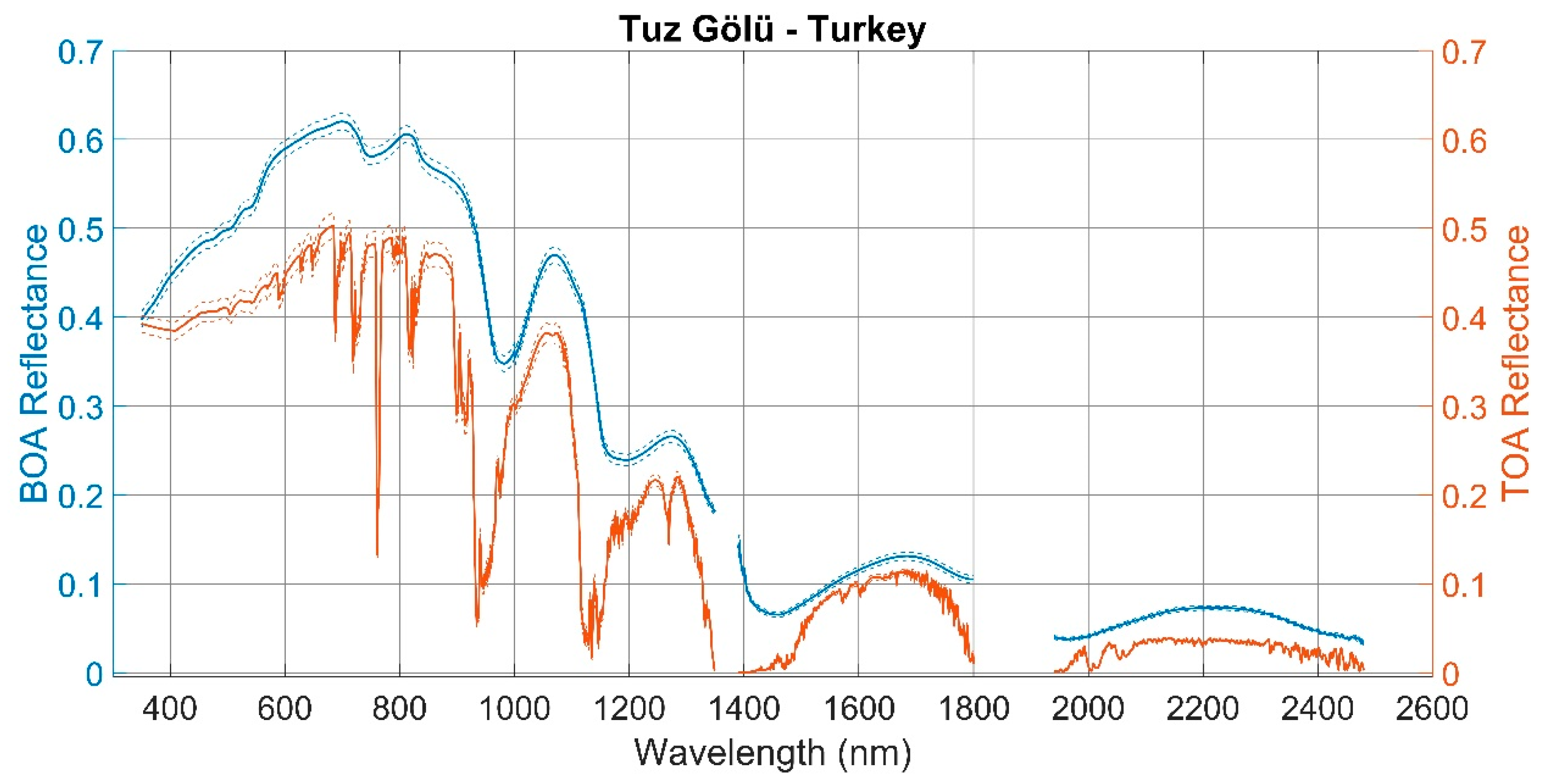

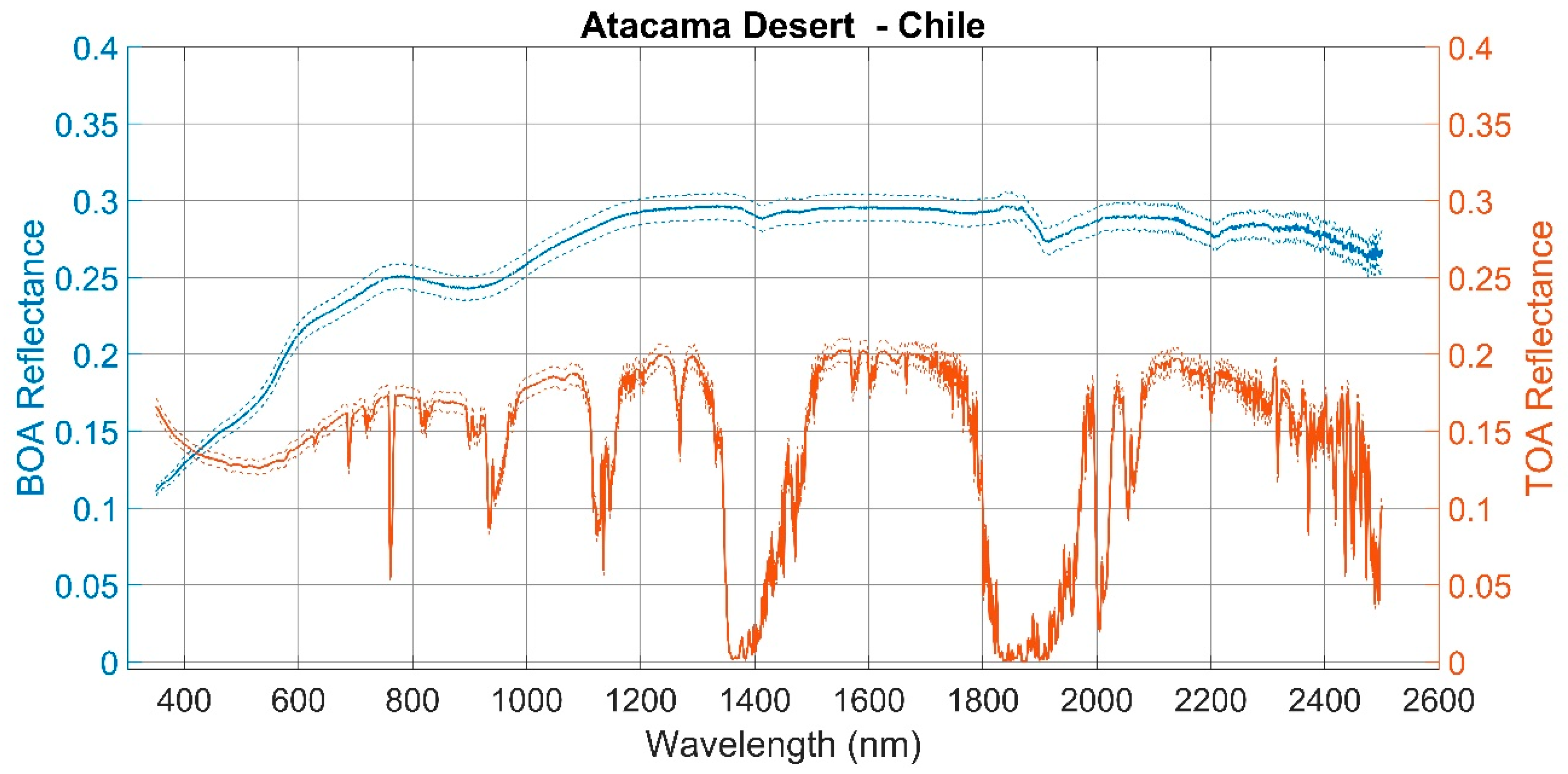
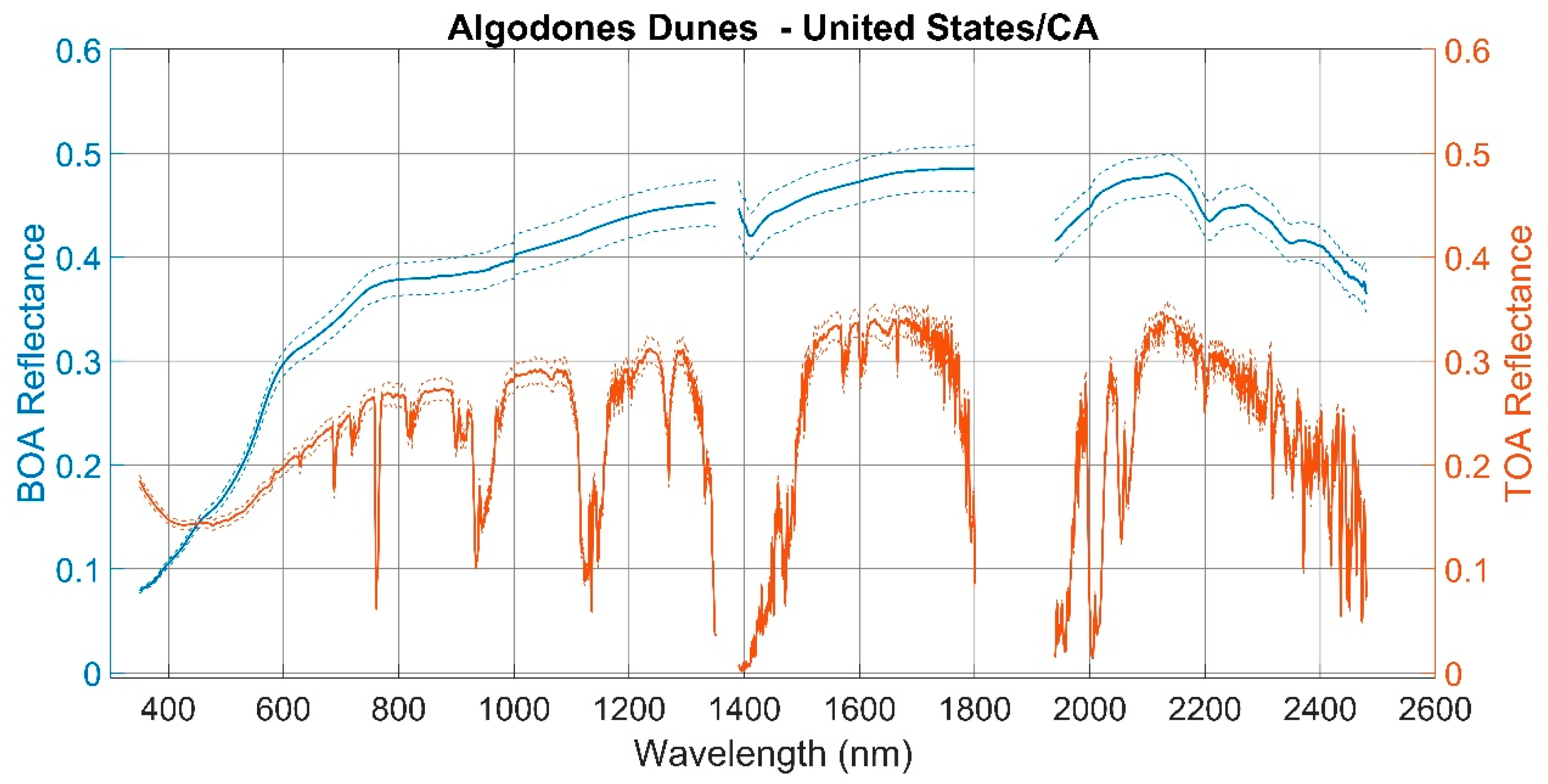
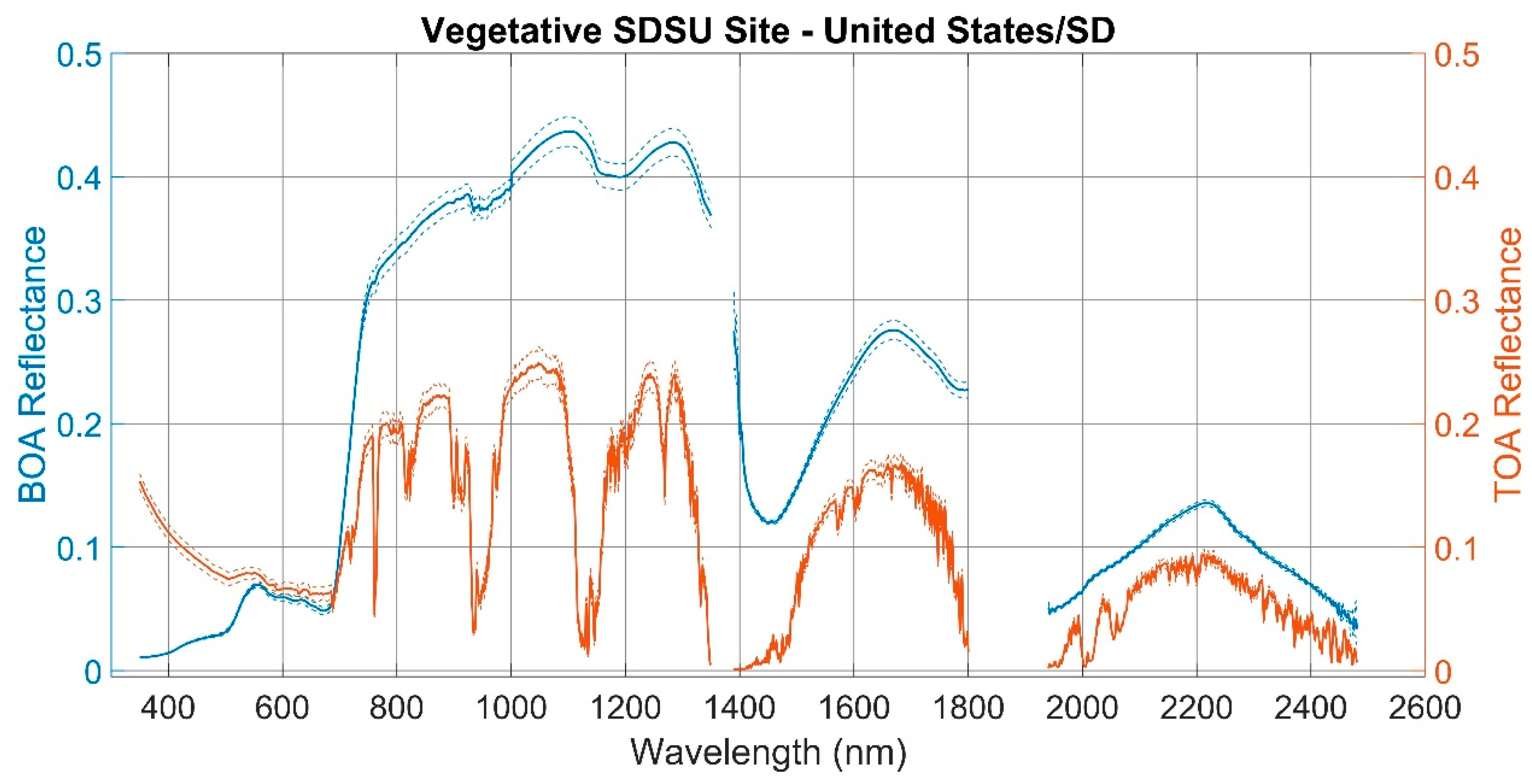
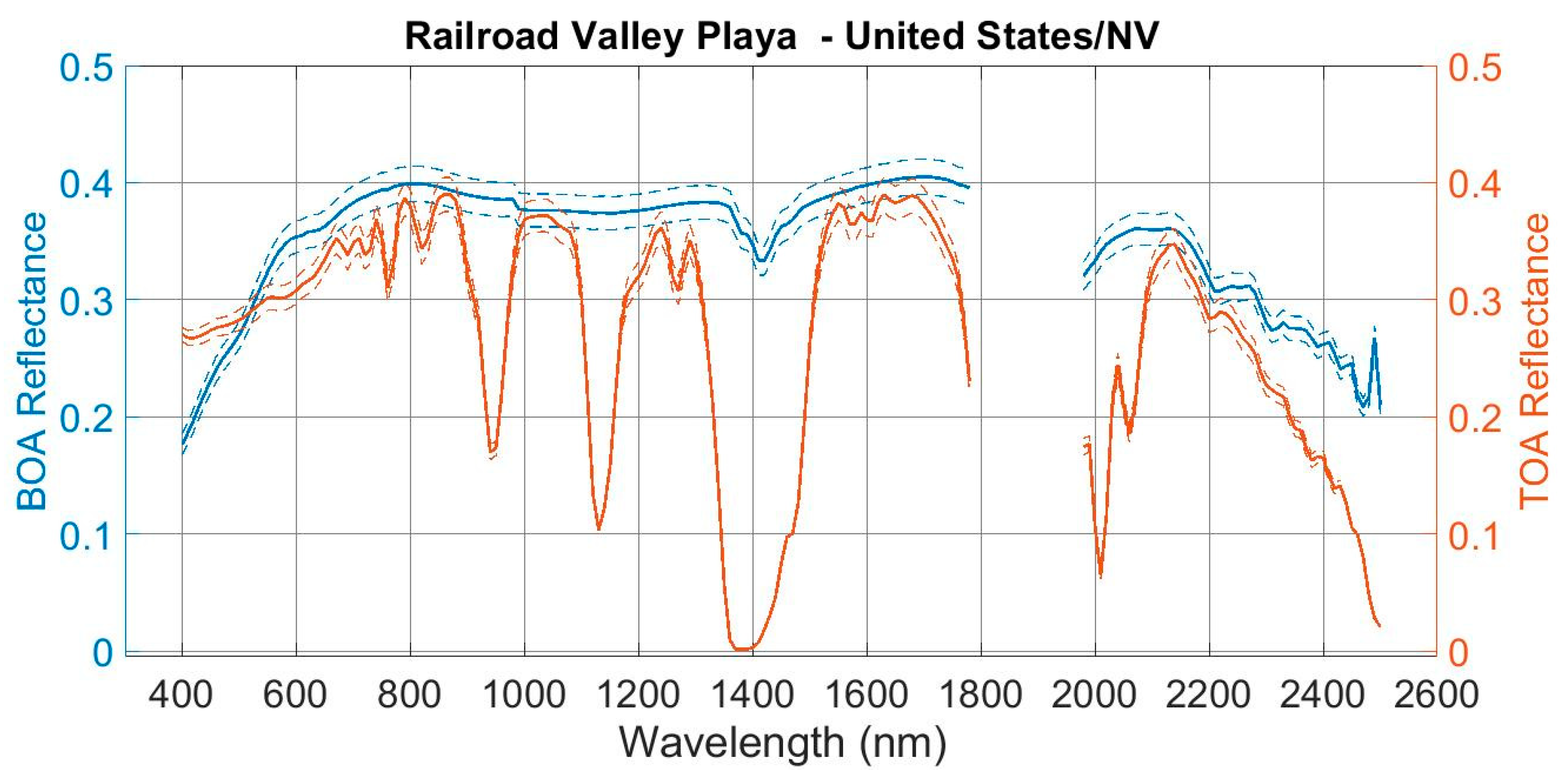
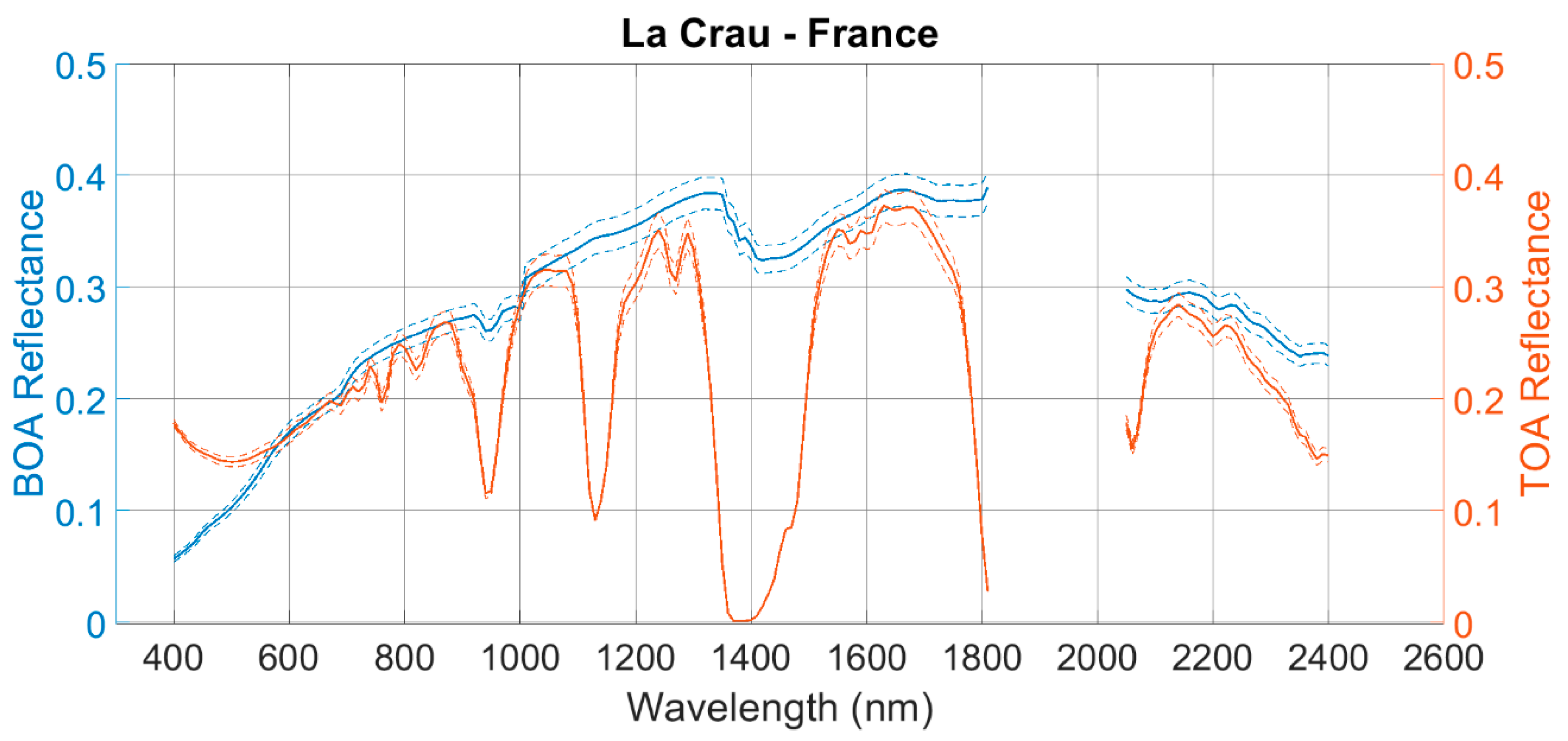
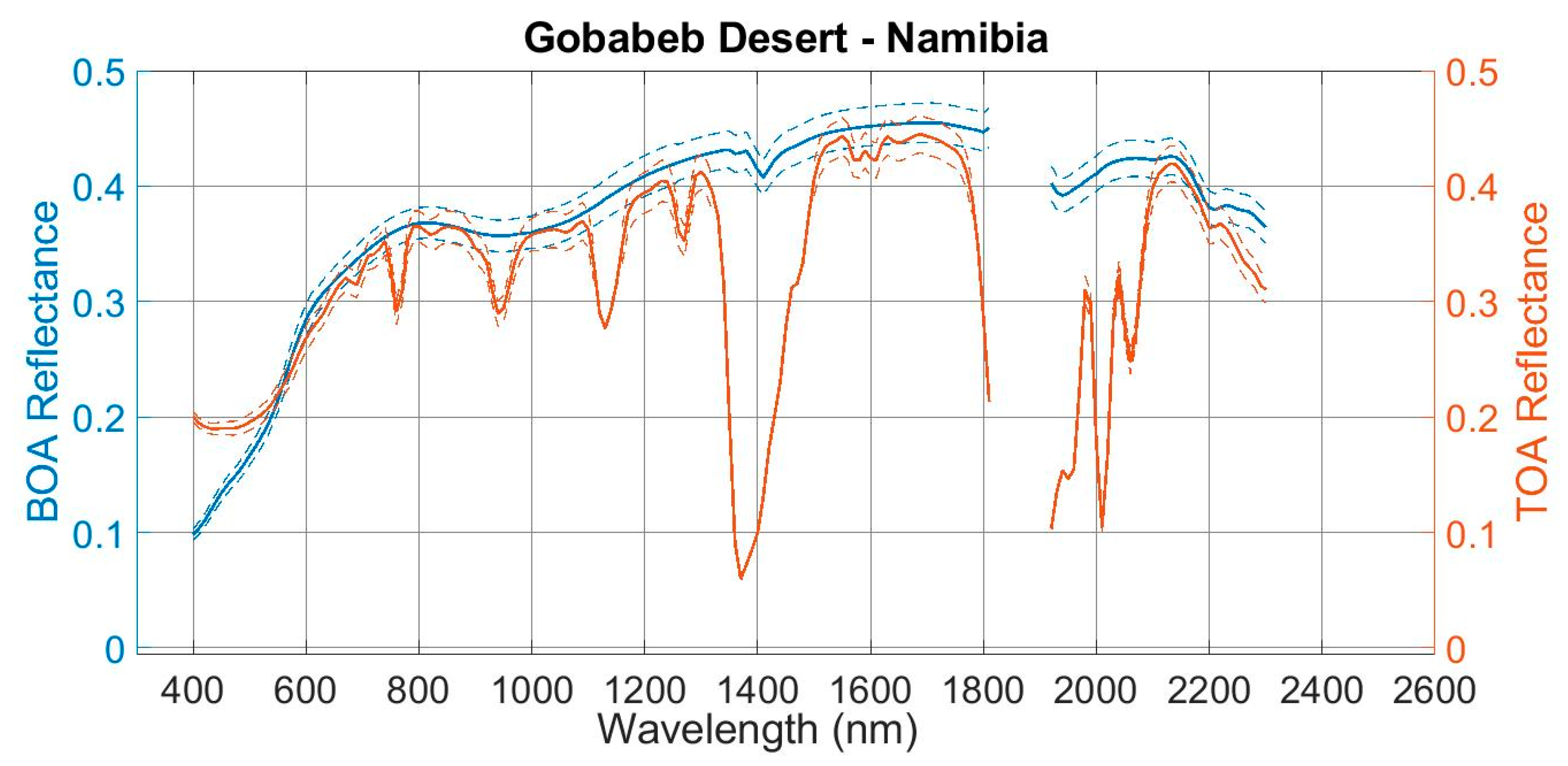
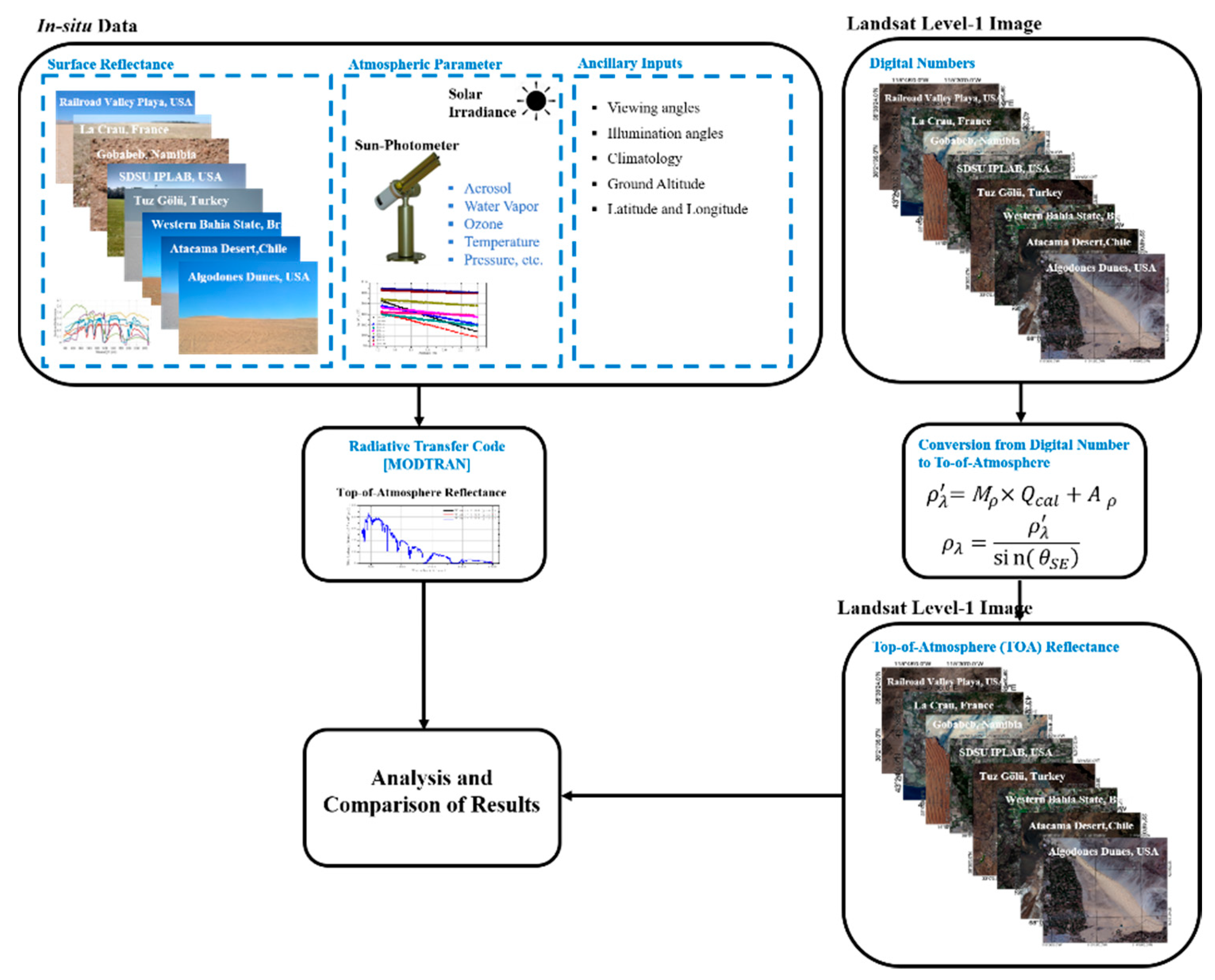
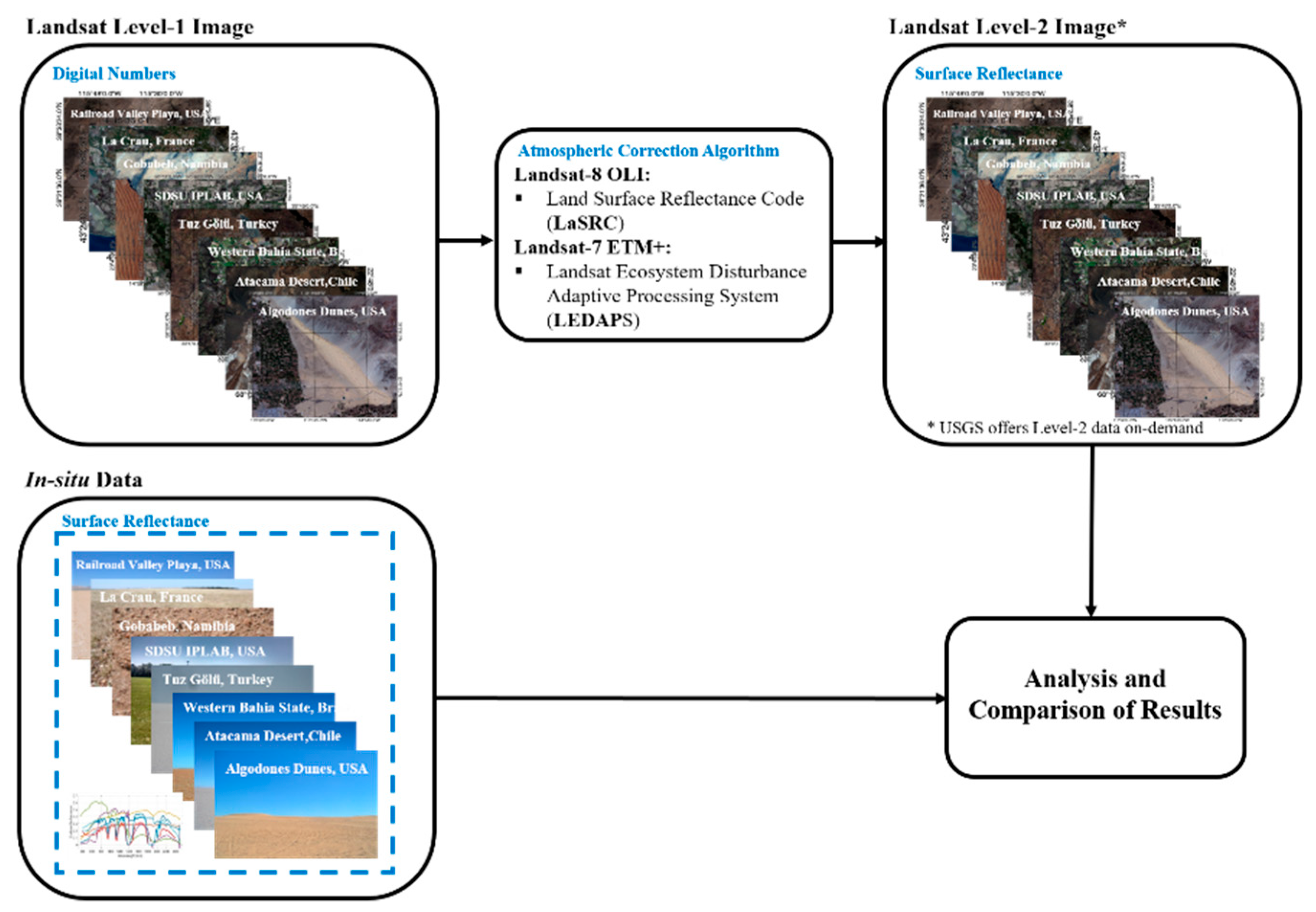
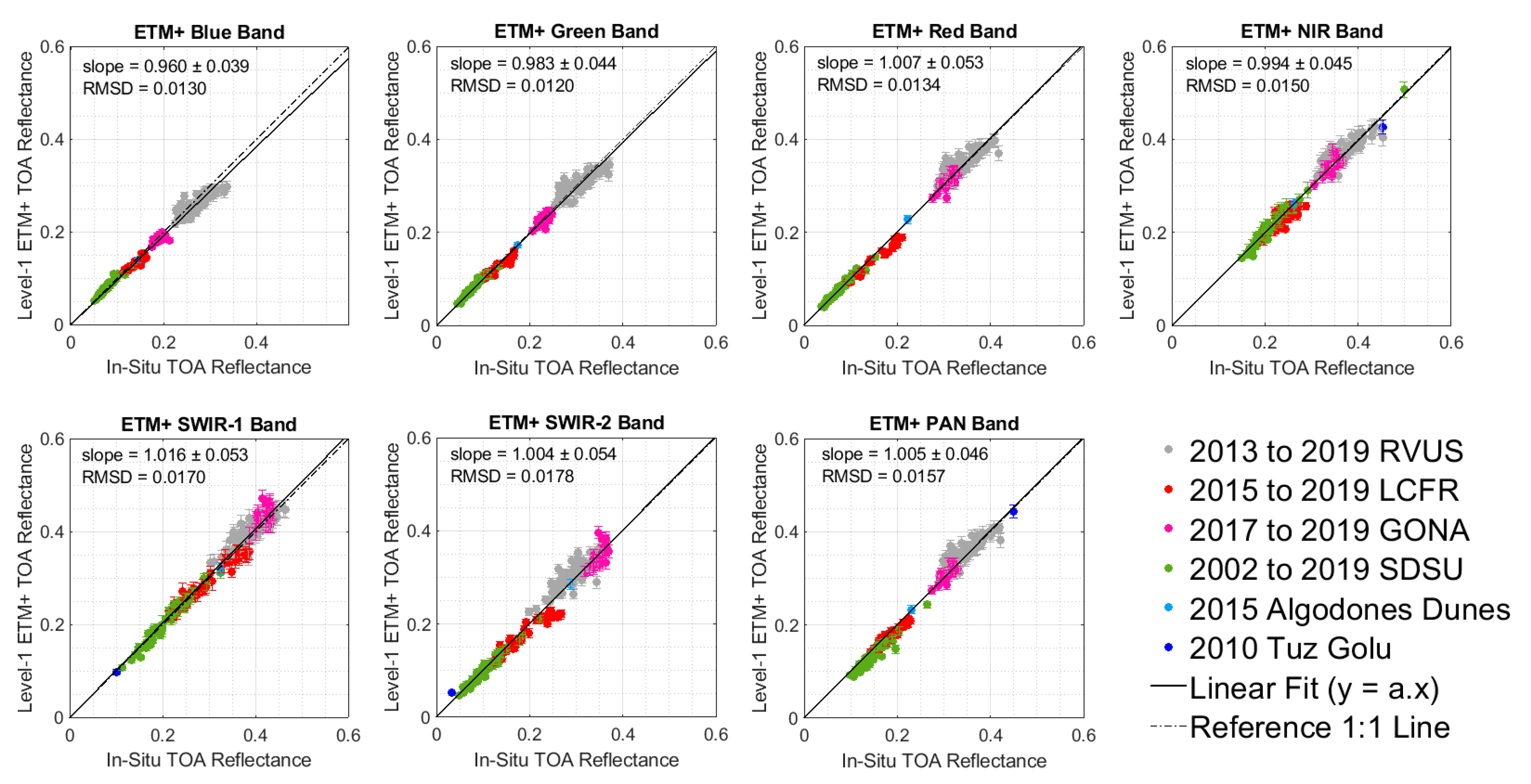
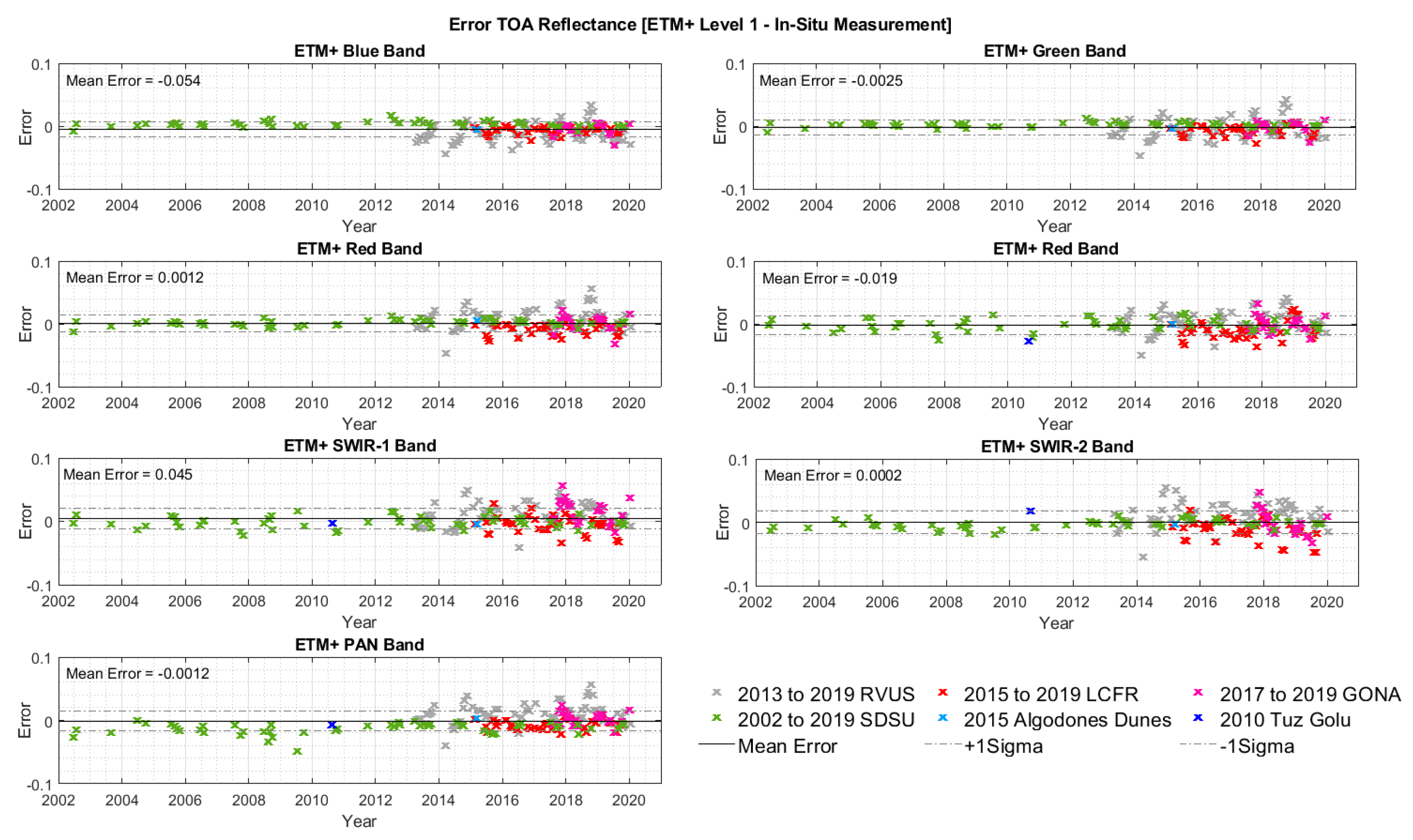
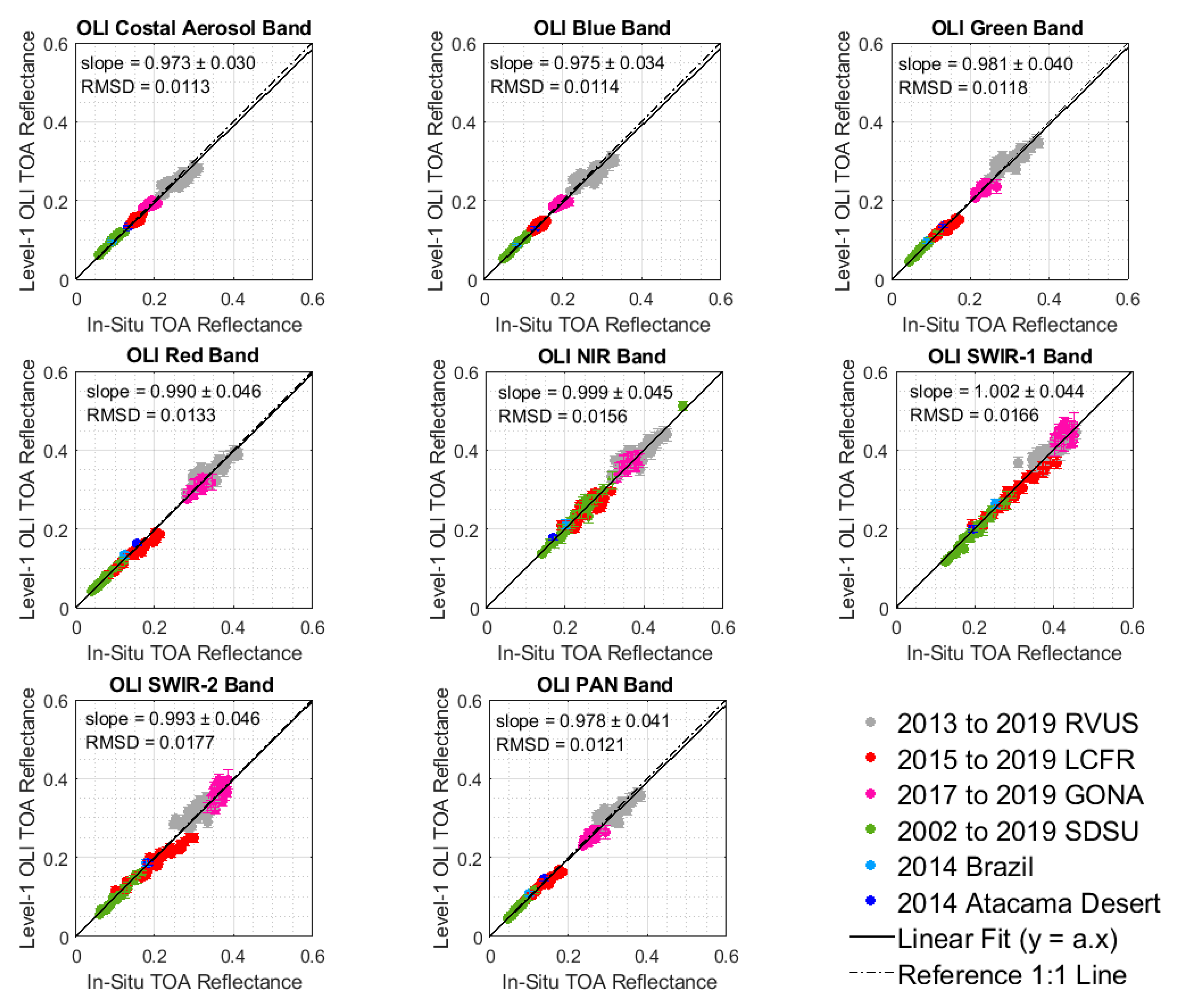
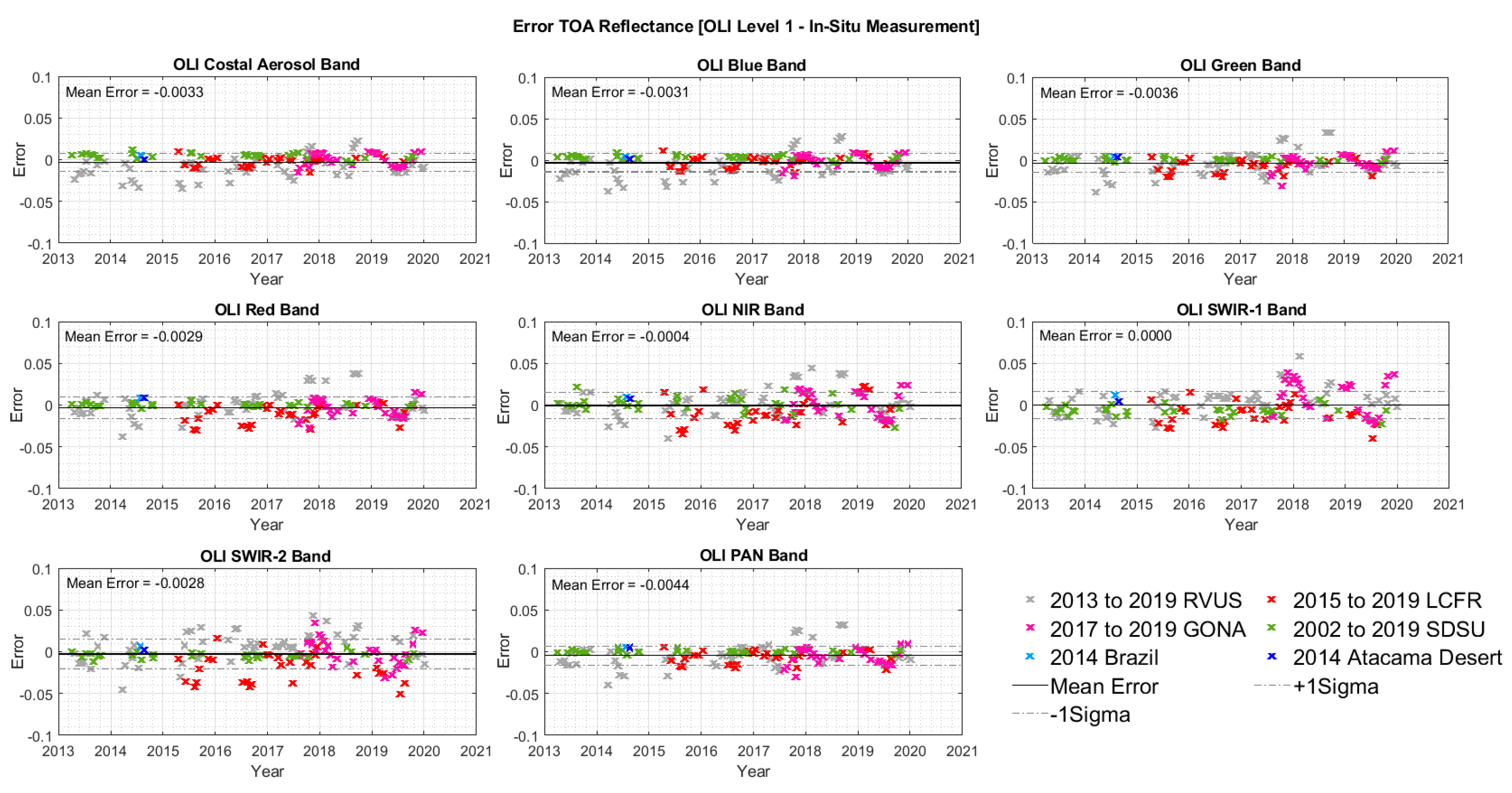
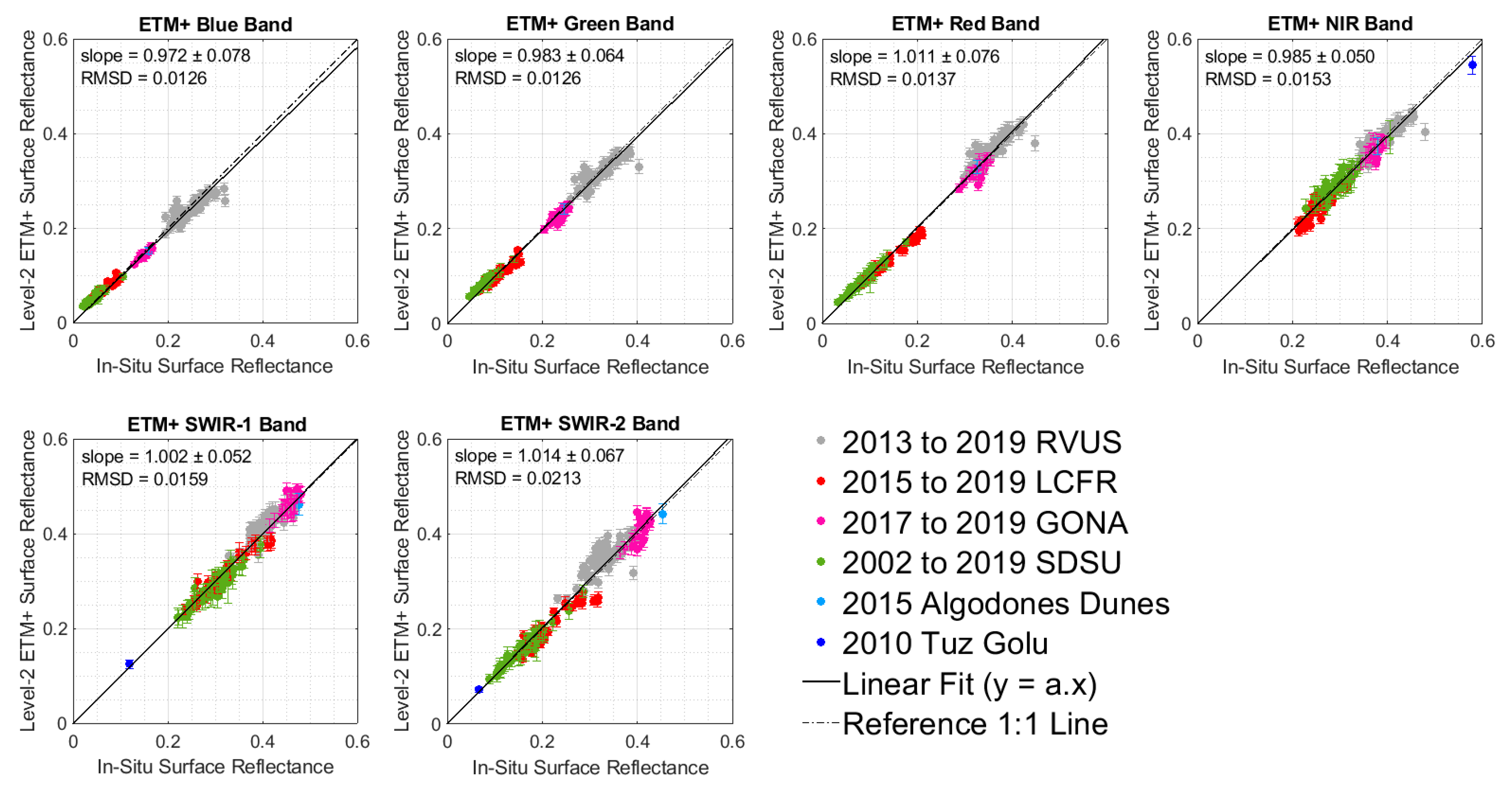
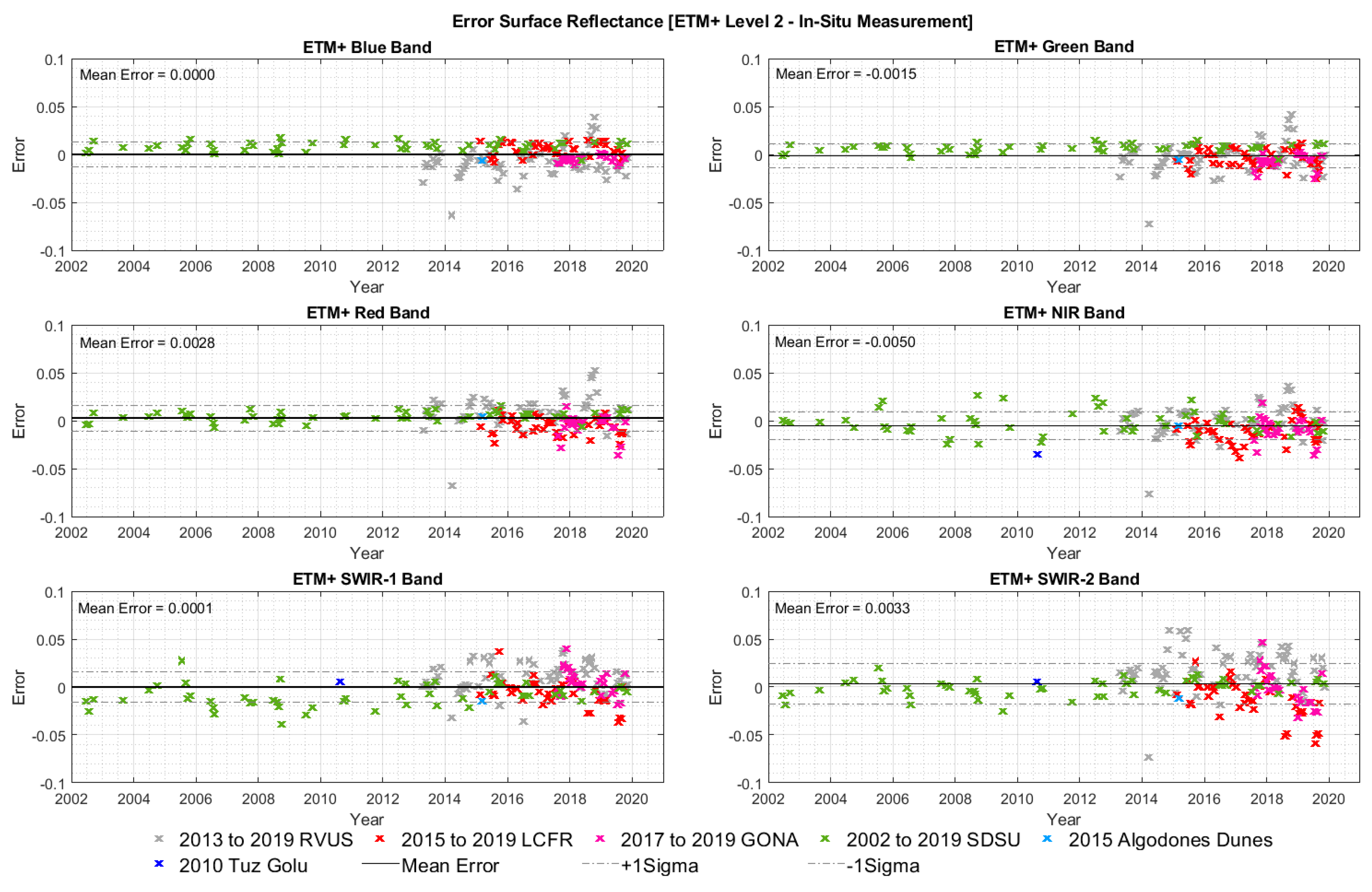
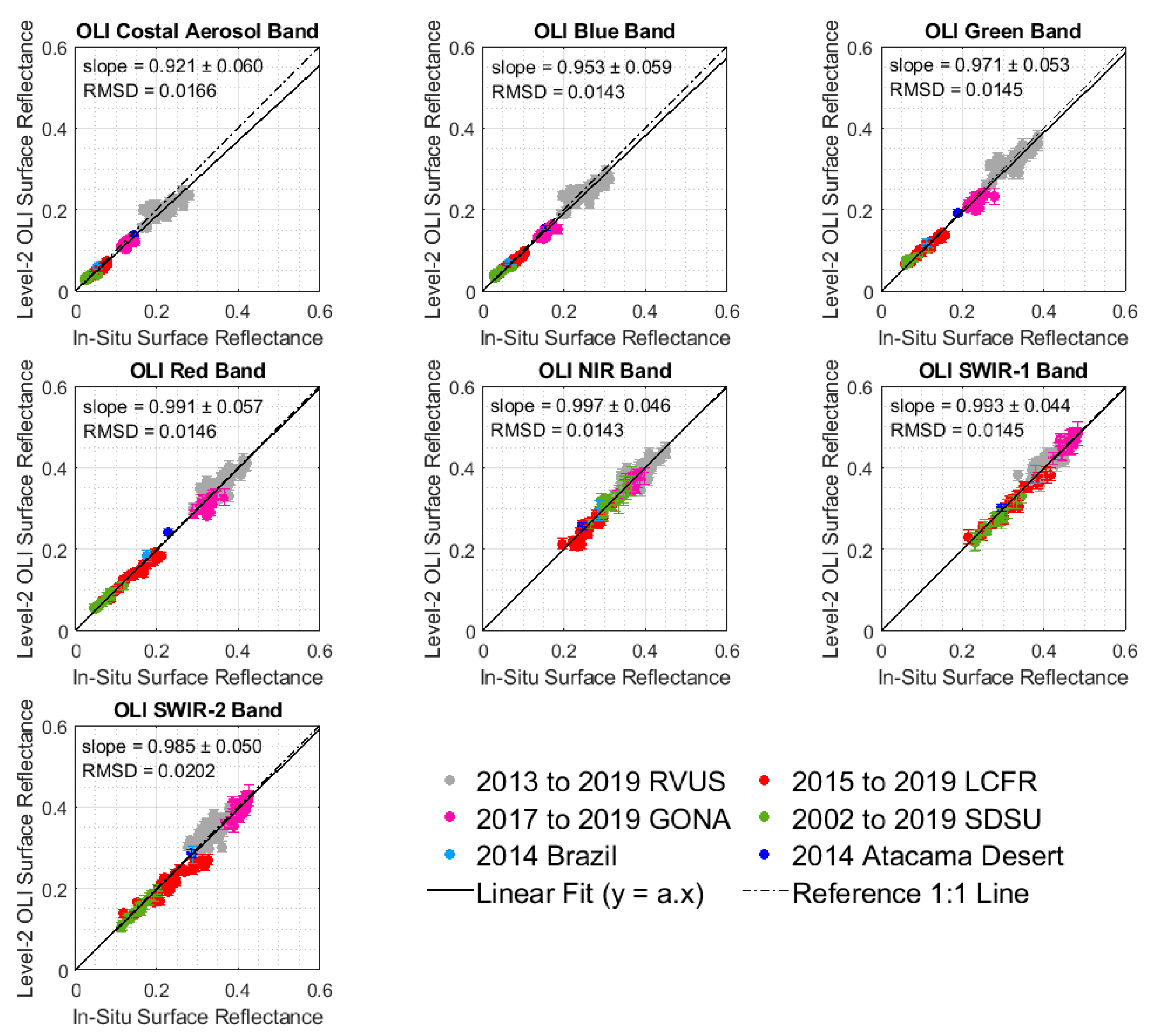
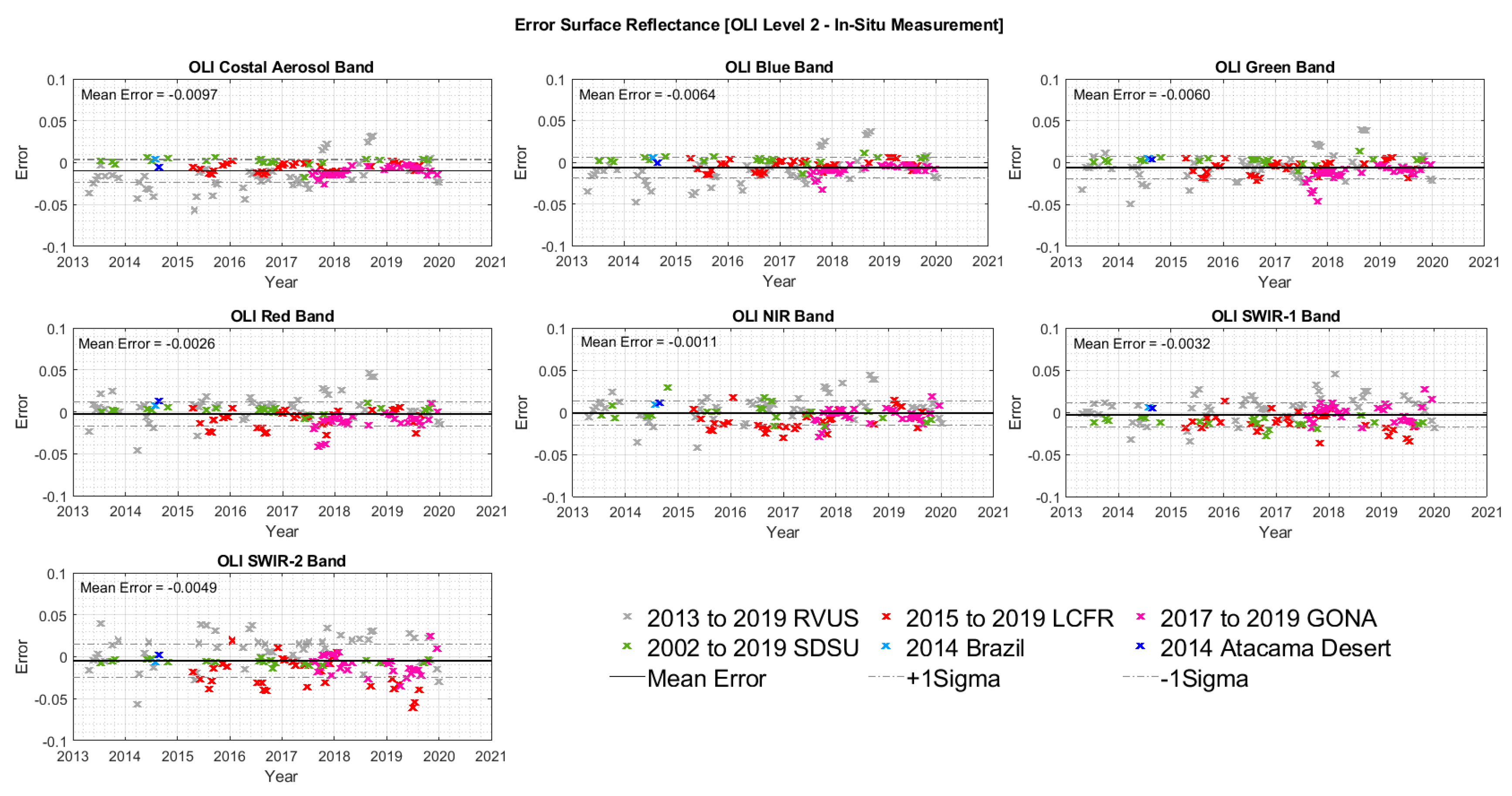
| Site Name | Country | Path/Row | Coordinate | Date | Land Cover | Satellites | Cases | In situ Technique |
|---|---|---|---|---|---|---|---|---|
| Tuz Gölü | Turkey | 176/33 | 38°47′20.83″ N 33°24′25.36″ E | 08/19/2010 | Saline Lake | Landsat 7 | 1 | On-site Personnel |
| Bahia | Brazil | 220/69 | 12°23′23.00″ S 46°5′25.00″ W | 07/25/2014 | Soil/Spare Vegetation | Landsat 8 | 1 | On-site Personnel |
| Atacama Desert | Chile | 233/76 | 23°8′11.00″ S 68°4′5.00″ W | 08/21/2014 | Sand Dunes | Landsat 8 | 1 | On-site Personnel |
| Algodones Dunes | USA | 39/37 | 32°54′40.00″ N 115°7′5.00″ W | 03/10/2015 | Sand Dunes | Landsat 7 | 1 | On-site Personnel |
| SDSU | USA | 29/29 | 44°17′29.41″ N 96°45′53.15″ W | 2002 to 2019 | Vegetation | Landsat 7 Landsat 8 | 54 30 | On-site Personnel |
| RVUS | USA | 40/33 | 38°29′49.20″ N 115°41′24.00″ W | 2013 to 2019 | Dry Lakebed | Landsat 7 Landsat 8 | 66 56 | RadCalNet |
| LCFR | France | 196/30 | 43°33′32.00″ N 4°51′51.00″ E | 2015 to 2019 | Pebbly Soil/Spare Vegetation | Landsat 7 Landsat 8 | 37 31 | RadCalNet |
| GONA | Namibia | 179/76 | 23°36′0.72′ S 15°70′10.56′ E | 2017 to 2019 | Gravel Plains | Landsat 7 Landsat 8 | 24 31 | RadCalNet |
| Spectral Band | Statistics | RVUS | LCFR | GONA | SDSU | AD | Tuz Gölü | All Sites Together |
|---|---|---|---|---|---|---|---|---|
| Blue Band | Slope | 0.953 | 0.948 | 0.978 | 1.037 | 0.960 | Satured | 0.960 |
| RMSD | 0.0191 | 0.0090 | 0.0092 | 0.0054 | 0.0058 | Satured | 0.0130 | |
| ME | −0.0121 | −0.0067 | −0.0040 | 0.0031 | −0.0058 | Satured | −0.0054 | |
| MPAE | 6.17% | 5.33% | 3.47% | 4.79% | 4.18% | Satured | 5.22% | |
| MPE | −4.54% | −5.05% | −2.15% | 3.73% | −4.18% | Satured | −1.87% | |
| Green Band | Slope | 0.983 | 0.939 | 0.995 | 1.024 | 0.982 | Satured | 0.983 |
| RMSD | 0.0173 | 0.0106 | 0.0080 | 0.0044 | 0.0031 | Satured | 0.0120 | |
| ME | −0.0042 | −0.0069 | −0.0011 | 0.0020 | −0.0031 | Satured | −0.0025 | |
| MPAE | 4.63% | 6.09% | 2.64% | 4.38% | 1.80% | Satured | 4.57% | |
| MPE | −1.29% | −5.20% | −0.55% | 2.53% | −1.80% | Satured | −0.86% | |
| Red Band | Slope | 1.015 | 0.927 | 1.007 | 1.018 | 1.022 | Satured | 1.007 |
| RMSD | 0.0182 | 0.0129 | 0.0117 | 0.0050 | 0.0050 | Satured | 0.0134 | |
| ME | 0.0064 | −0.0093 | 0.0021 | 0.0017 | 0.0050 | Satured | 0.0012 | |
| MPAE | 3.94% | 6.81% | 3.11% | 5.18% | 2.19% | Satured | 4.77% | |
| MPE | 1.89% | −6.19% | 0.55% | 2.27% | 2.19% | Satured | 0.18% | |
| NIR Band | Slope | 1.003 | 0.955 | 0.999 | 0.996 | 0.997 | 0.940 | 0.994 |
| RMSD | 0.0178 | 0.0173 | 0.0122 | 0.0095 | 0.0008 | 0.0273 | 0.0150 | |
| ME | 0.0021 | −0.0100 | −0.0003 | −0.0014 | −0.0008 | −0.0273 | −0.0019 | |
| MPAE | 3.71% | 6.37% | 2.72% | 3.97% | 0.30% | 6.41% | 4.19% | |
| MPE | 0.64% | −4.51% | −0.20% | −1.23% | −0.30% | −6.41% | −1.11% | |
| SWIR-1 Band | Slope | 1.025 | 0.977 | 1.041 | 0.995 | 0.986 | 0.976 | 1.016 |
| RMSD | 0.0200 | 0.0148 | 0.0242 | 0.0091 | 0.0046 | 0.0024 | 0.0170 | |
| ME | 0.0106 | −0.0055 | 0.0172 | −0.0016 | −0.0046 | −0.0024 | 0.0045 | |
| MPAE | 3.92% | 3.68% | 4.50% | 3.93% | 1.43% | 2.42% | 3.93% | |
| MPE | 2.70% | −1.55% | 3.81% | −1.38% | −1.43% | −2.42% | 0.74% | |
| SWIR-2 Band | Slope | 1.034 | 0.916 | 0.997 | 0.968 | 0.989 | 1.544 | 1.004 |
| RMSD | 0.0214 | 0.0211 | 0.0183 | 0.0074 | 0.0031 | 0.0184 | 0.0178 | |
| ME | 0.0110 | −0.0137 | −0.0011 | −0.0032 | −0.0031 | 0.0184 | 0.0002 | |
| MPAE | 5.48% | 8.89% | 4.13% | 6.24% | 1.09% | 35.23% | 6.36% | |
| MPE | 3.60% | −7.16% | −0.61% | −3.45% | −1.09% | 35.23% | −1.06% | |
| PAN Band | Slope | 1.025 | 0.956 | 1.012 | 0.912 | 1.013 | 0.984 | 1.005 |
| RMSD | 0.0192 | 0.0111 | 0.0105 | 0.0156 | 0.0030 | 0.0072 | 0.0157 | |
| ME | 0.0100 | −0.0076 | 0.0037 | −0.0128 | 0.0030 | −0.0072 | −0.0012 | |
| MPAE | 4.15% | 5.14% | 2.79% | 9.88% | 1.29% | 1.63% | 5.81% | |
| MPE | 2.85% | −4.13% | 1.11% | −9.88% | 1.29% | −1.63% | −2.54% |
| Spectral Band | Statistics | RVUS | LCFR | GONA | SDSU | Brazil | Chile | All Sites Together |
|---|---|---|---|---|---|---|---|---|
| CA Band | Slope | 0.958 | 0.985 | 0.997 | 1.052 | 1.055 | 1.001 | 0.973 |
| RMSD | 0.0166 | 0.0059 | 0.0075 | 0.0056 | 0.0051 | 0.0002 | 0.0113 | |
| ME | −0.0101 | −0.0022 | −0.0002 | 0.0047 | 0.0051 | 0.0002 | −0.0033 | |
| MPAE | 5.43% | 3.07% | 3.47% | 5.22% | 5.23% | 0.14% | 4.46% | |
| MPE | −3.92% | −1.50% | −0.09% | 4.94% | 5.23% | 0.14% | −0.73% | |
| Blue Band | Slope | 0.967 | 0.981 | 0.991 | 1.041 | 1.055 | 1.011 | 0.975 |
| RMSD | 0.0167 | 0.0073 | 0.0080 | 0.0040 | 0.0046 | 0.0014 | 0.0114 | |
| ME | −0.0082 | −0.0023 | −0.0014 | 0.0033 | 0.0046 | 0.0014 | −0.0031 | |
| MPAE | 5.08% | 4.23% | 3.51% | 4.22% | 5.23% | 1.04% | 4.38% | |
| MPE | −2.96% | −1.66% | −0.74% | 4.02% | 5.23% | 1.04% | −0.72% | |
| Green Band | Slope | 0.982 | 0.942 | 0.985 | 1.009 | 1.057 | 1.030 | 0.981 |
| RMSD | 0.0162 | 0.0106 | 0.0095 | 0.0022 | 0.0052 | 0.0039 | 0.0118 | |
| ME | −0.0046 | −0.0068 | −0.0034 | 0.0007 | 0.0052 | 0.0039 | −0.0036 | |
| MPAE | 4.28% | 6.17% | 3.17% | 2.03% | 5.41% | 2.87% | 3.97% | |
| MPE | −1.39% | −4.97% | −1.48% | 0.74% | 5.41% | 2.87% | −1.63% | |
| Red Band | Slope | 0.999 | 0.914 | 0.984 | 1.003 | 1.065 | 1.054 | 0.990 |
| RMSD | 0.0160 | 0.0159 | 0.0117 | 0.0020 | 0.0081 | 0.0083 | 0.0133 | |
| ME | 0.0008 | −0.0115 | −0.0047 | 0.0002 | 0.0081 | 0.0083 | −0.0029 | |
| MPAE | 3.49% | 7.87% | 3.24% | 2.48% | 6.11% | 5.08% | 4.16% | |
| MPE | 0.28% | −7.44% | −1.57% | 0.15% | 6.11% | 5.08% | −1.64% | |
| NIR Band | Slope | 1.004 | 0.958 | 1.002 | 1.009 | 1.049 | 1.048 | 0.999 |
| RMSD | 0.0171 | 0.0187 | 0.0148 | 0.0094 | 0.0099 | 0.0081 | 0.0156 | |
| ME | 0.0027 | −0.0100 | 0.0011 | 0.0016 | 0.0099 | 0.0081 | −0.0004 | |
| MPAE | 3.19% | 6.69% | 3.71% | 2.93% | 4.64% | 4.57% | 3.98% | |
| MPE | 0.76% | −4.04% | 0.24% | 0.23% | 4.64% | 4.57% | −0.39% | |
| SWIR-1 Band | Slope | 1.010 | 0.959 | 1.020 | 0.967 | 1.048 | 1.023 | 1.002 |
| RMSD | 0.0160 | 0.0169 | 0.0225 | 0.0092 | 0.0121 | 0.0045 | 0.0166 | |
| ME | 0.0048 | −0.0112 | 0.0091 | −0.0070 | 0.0121 | 0.0045 | 1.860 × 10−5 | |
| MPAE | 3.05% | 4.58% | 4.56% | 4.46% | 4.57% | 2.24% | 3.97% | |
| MPE | 1.28% | −3.40% | 1.94% | −4.04% | 4.57% | 2.24% | −0.61% | |
| SWIR-2 Band | Slope | 1.014 | 0.900 | 0.999 | 0.960 | 1.036 | 1.011 | 0.993 |
| RMSD | 0.0181 | 0.0256 | 0.0155 | 0.0057 | 0.0065 | 0.0021 | 0.0177 | |
| ME | 0.0052 | −0.0186 | -0.0004 | −0.0045 | 0.0065 | 0.0021 | −0.0028 | |
| MPAE | 4.79% | 10.74% | 3.42% | 5.11% | 3.47% | 1.10% | 5.76% | |
| MPE | 1.61% | −8.84% | −0.28% | −4.67% | 3.47% | 1.10% | −2.20 | |
| PAN Band | Slope | 0.981 | 0.948 | 0.975 | 0.998 | 1.052 | 1.034 | 0.978 |
| RMSD | 0.0162 | 0.0102 | 0.0114 | 0.0019 | 0.0053 | 0.0047 | 0.0121 | |
| ME | −0.0050 | −0.0064 | −0.0063 | −0.0002 | 0.0053 | 0.0047 | −0.0044 | |
| MPAE | 4.11% | 5.41% | 3.64% | 2.18% | 4.91% | 3.26% | 3.88% | |
| MPE | −1.50% | −4.26% | −2.51% | −0.40% | 4.91% | 3.26% | −1.97% |
| Spectral Band | Statistics | RVUS | LCFR | GONA | SDSU | AD | Tuz Gölü | All Sites Together |
|---|---|---|---|---|---|---|---|---|
| Blue Band | Slope | 0.964 | 1.058 | 0.965 | 1.155 | 0.959 | Satured | 0.972 |
| RMSD | 0.0173 | 0.0090 | 0.0063 | 0.0097 | 0.0066 | Satured | 0.0126 | |
| ME | −0.0080 | 0.0057 | −0.0052 | 0.0085 | −0.0066 | Satured | 8.18 × 10−7 | |
| MPAE | 5.51% | 11.36% | 3.63% | 17.73% | 4.31% | Satured | 9.98% | |
| MPE | −3.23% | 9.03% | −3.55% | 17.49% | −4.31% | Satured | 5.25% | |
| Green Band | Slope | 0.985 | 0.949 | 0.968 | 1.075 | 0.978 | Satured | 0.983 |
| RMSD | 0.0168 | 0.0106 | 0.0104 | 0.0079 | 0.0055 | Satured | 0.0126 | |
| ME | −0.0040 | −0.0042 | −0.0075 | 0.0066 | −0.0055 | Satured | −0.0015 | |
| MPAE | 3.60% | 8.48% | 3.50% | 9.00% | 2.27% | Satured | 6.15% | |
| MPE | −1.21% | −3.41% | −3.36% | 8.60% | −2.27% | Satured | 0.84% | |
| Red Band | Slope | 1.024 | 0.946 | 0.984 | 1.038 | 1.012 | Satured | 1.011 |
| RMSD | 0.0188 | 0.0109 | 0.0121 | 0.0069 | 0.0041 | Satured | 0.0137 | |
| ME | 0.0096 | −0.0062 | −0.0053 | 0.0046 | 0.0041 | Satured | 0.0028 | |
| MPAE | 3.73% | 6.04% | 2.43% | 7.44% | 1.23% | Satured | 5.09% | |
| MPE | 2.61% | −3.75% | −1.73% | 6.21% | 1.23% | Satured | 1.70% | |
| NIR Band | Slope | 0.995 | 0.951 | 0.975 | 0.992 | 0.985 | 0.940 | 0.985 |
| RMSD | 0.0161 | 0.0168 | 0.0150 | 0.0125 | 0.0057 | 0.0347 | 0.0153 | |
| ME | −0.0011 | −0.0121 | −0.0092 | −0.0019 | −0.0057 | −0.0347 | −0.0050 | |
| MPAE | 2.92% | 5.87% | 3.19% | 3.40% | 1.51% | 6.37% | 3.72% | |
| MPE | −0.28% | −5.12% | −2.63% | −0.67% | −1.51% | −6.37% | −1.77% | |
| SWIR-1 Band | Slope | 1.022 | 0.976 | 1.013 | 0.967 | 0.968 | 1.044 | 1.002 |
| RMSD | 0.0175 | 0.0153 | 0.0144 | 0.0150 | 0.0151 | 0.0053 | 0.0159 | |
| ME | 0.0096 | −0.0067 | 0.0059 | −0.0093 | −0.0151 | 0.0053 | 0.0001 | |
| MPAE | 3.24% | 3.53% | 2.43% | 4.27% | 3.25% | 4.20% | 3.49% | |
| MPE | 2.25% | −1.93% | 1.19% | −3.17% | −3.25% | 4.20% | −0.34% | |
| SWIR-2 Band | Slope | 1.053 | 0.928 | 1.000 | 0.986 | 0.974 | 1.074 | 1.014 |
| RMSD | 0.0274 | 0.0238 | 0.0181 | 0.0088 | 0.0119 | 0.0050 | 0.0213 | |
| ME | 0.0183 | −0.0136 | −0.0001 | −0.0011 | −0.0119 | 0.0050 | 0.0033 | |
| MPAE | 6.44% | 8.21% | 3.49% | 4.45% | 2.70% | 6.91% | 5.82% | |
| MPE | 5.15% | −6.10% | −0.25% | −0.27% | −2.70% | 6.91% | 0.48% |
| Spectral Band | Statistics | RVUS | LCFR | GONA | SDSU | Brazil | Chile | All Sites Together |
|---|---|---|---|---|---|---|---|---|
| CA Band | Slope | 0.922 | 0.887 | 0.917 | 1.016 | 1.080 | 0.961 | 0.921 |
| RMSD | 0.0239 | 0.0081 | 0.0121 | 0.0049 | 0.0044 | 0.0056 | 0.0166 | |
| ME | −0.0157 | −0.0062 | −0.0107 | 0.0014 | 0.0044 | −0.0056 | −0.0097 | |
| MPAE | 10.28% | 11.61% | 9.00% | 10.04% | 7.40% | 4.05% | 10.18% | |
| MPE | −7.67% | −10.84% | −9.00% | 4.64% | 7.40% | −4.05% | −6.75% | |
| Blue Band | Slope | 0.956 | 0.933 | 0.940 | 1.043 | 1.095 | 0.999 | 0.953 |
| RMSD | 0.0201 | 0.0075 | 0.0112 | 0.0054 | 0.0062 | 0.0001 | 0.0143 | |
| ME | −0.0099 | −0.0040 | −0.0093 | 0.0028 | 0.0062 | −0.0001 | −0.0064 | |
| MPAE | 6.75% | 8.00% | 6.32% | 9.65% | 8.69% | 0.07% | 7.32% | |
| MPE | −4.04% | −4.68% | −6.32% | 7.18% | 8.69% | −0.07% | −2.95% | |
| Green Band | Slope | 0.981 | 0.934 | 0.945 | 1.028 | 1.050 | 1.021 | 0.971 |
| RMSD | 0.0177 | 0.0102 | 0.0162 | 0.0050 | 0.0057 | 0.0040 | 0.0145 | |
| ME | −0.0052 | −0.0066 | −0.0129 | 0.0027 | 0.0057 | 0.0040 | −0.0060 | |
| MPAE | 4.22% | 7.23% | 5.78% | 5.24% | 4.81% | 2.09% | 5.38% | |
| MPE | −1.60% | −5.38% | −5.73% | 3.83% | 4.81% | 2.09% | −2.53% | |
| Red Band | Slope | 1.010 | 0.929 | 0.963 | 1.015 | 1.043 | 1.056 | 0.991 |
| RMSD | 0.0169 | 0.0136 | 0.0159 | 0.0043 | 0.0076 | 0.0127 | 0.0146 | |
| ME | 0.0044 | −0.0090 | −0.0119 | 0.0019 | 0.0076 | 0.0127 | −0.0026 | |
| MPAE | 3.46% | 7.08% | 4.00% | 4.66% | 4.14% | 5.26% | 4.58% | |
| MPE | 1.23% | −5.71% | −3.82% | 3.05% | 4.14% | 5.26% | −1.16% | |
| NIR Band | Slope | 1.011 | 0.962 | 0.988 | 0.997 | 1.033 | 1.047 | 0.997 |
| RMSD | 0.0169 | 0.0153 | 0.0099 | 0.0107 | 0.0093 | 0.0114 | 0.0143 | |
| ME | 0.0051 | −0.0099 | −0.0041 | −0.0005 | 0.0093 | 0.0114 | −0.0011 | |
| MPAE | 3.26% | 5.46% | 1.96% | 2.49% | 3.16% | 4.46% | 3.35% | |
| MPE | 1.31% | −4.02% | −1.15% | −0.16% | 3.16% | 4.46% | −0.62% | |
| SWIR-1 Band | Slope | 1.009 | 0.959 | 0.998 | 0.956 | 1.016 | 1.018 | 0.993 |
| RMSD | 0.0157 | 0.0168 | 0.0104 | 0.0136 | 0.0062 | 0.0052 | 0.0145 | |
| ME | 0.0042 | −0.0129 | −0.0010 | −0.0124 | 0.0062 | 0.0052 | −0.0032 | |
| MPAE | 3.01% | 4.46% | 1.87% | 4.59% | 1.61% | 1.74% | 3.29% | |
| MPE | 1.01% | −3.91% | −0.24% | −4.59% | 1.61% | 1.74% | −1.18% | |
| SWIR-2 Band | Slope | 1.020 | 0.902 | 0.976 | 0.960 | 0.979 | 1.008 | 0.985 |
| RMSD | 0.0212 | 0.0281 | 0.0151 | 0.0068 | 0.0061 | 0.0022 | 0.0202 | |
| ME | 0.0076 | −0.0212 | −0.0096 | −0.0061 | −0.0061 | 0.0022 | −0.0049 | |
| MPAE | 5.14% | 10.55% | 3.25% | 4.08% | 2.16% | 0.76% | 5.70% | |
| MPE | 2.11% | −9.09% | −2.53% | −4.08% | −2.16% | 0.76% | −2.38% |
© 2020 by the authors. Licensee MDPI, Basel, Switzerland. This article is an open access article distributed under the terms and conditions of the Creative Commons Attribution (CC BY) license (http://creativecommons.org/licenses/by/4.0/).
Share and Cite
Teixeira Pinto, C.; Jing, X.; Leigh, L. Evaluation Analysis of Landsat Level-1 and Level-2 Data Products Using In Situ Measurements. Remote Sens. 2020, 12, 2597. https://doi.org/10.3390/rs12162597
Teixeira Pinto C, Jing X, Leigh L. Evaluation Analysis of Landsat Level-1 and Level-2 Data Products Using In Situ Measurements. Remote Sensing. 2020; 12(16):2597. https://doi.org/10.3390/rs12162597
Chicago/Turabian StyleTeixeira Pinto, Cibele, Xin Jing, and Larry Leigh. 2020. "Evaluation Analysis of Landsat Level-1 and Level-2 Data Products Using In Situ Measurements" Remote Sensing 12, no. 16: 2597. https://doi.org/10.3390/rs12162597





